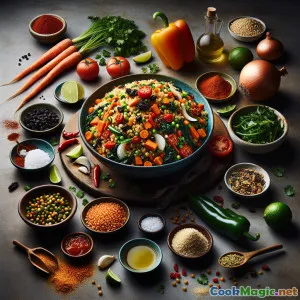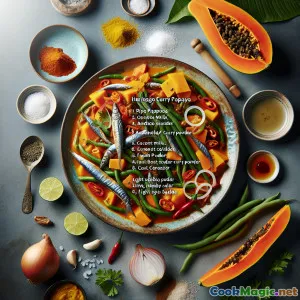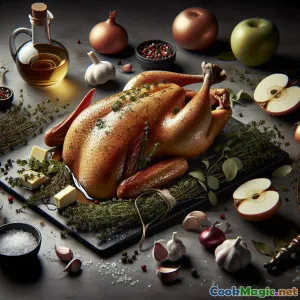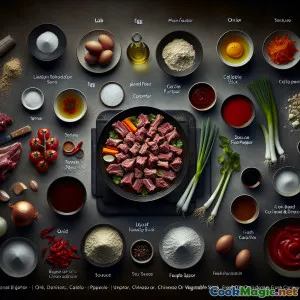
Яркое наслаждение руандским горным сорго пилфом
(Vibrant Rwandan Hillside Sorghum Pilaf Delight)
(0 Обзоры)0
33
июнь 24, 2025
Сообщить о проблеме
Ингредиенты
-
200 grams Цельное зерно сорго
(Soaked for at least 4 hours or overnight, thoroughly rinsed)
-
1 medium Лук
(Finely chopped, preferably red onion for sweetness)
-
3 pieces Чесночные зубчики
(Измельченный)
-
1 tbsp Имбирь
(Свеженатертый)
-
100 grams Морковь
(Diced small; adds color and sweetness)
-
1 medium Сладкий перец
(Red or yellow, finely diced)
-
75 grams Кольраби
(Shredded kale or spinach can be substituted)
-
2 small Помидор Рома
(Chopped; fresh for best flavor)
-
500 ml Овощной бульон
(Low sodium recommended, for simmering sorghum)
-
1 tsp Молотый кориандр
-
0.5 tsp Копченая паприка
(Adds warmth and color)
-
0.5 tsp Соль
(По вкусу)
-
0.25 tsp Чёрный перец
(Свежемолотый)
-
1.5 tbsp Кокосовое масло
(Can substitute neutral vegetable oil)
-
40 grams Изюм
(Adds subtle sweetness)
-
2 tbsp Свежий кинза
(Рубленый, для украшения)
-
4 pieces Дольки лайма
(Optional, for squeezing at the table)
(Soaked for at least 4 hours or overnight, thoroughly rinsed)
(Finely chopped, preferably red onion for sweetness)
(Измельченный)
(Свеженатертый)
(Diced small; adds color and sweetness)
(Red or yellow, finely diced)
(Shredded kale or spinach can be substituted)
(Chopped; fresh for best flavor)
(Low sodium recommended, for simmering sorghum)
(Adds warmth and color)
(По вкусу)
(Свежемолотый)
(Can substitute neutral vegetable oil)
(Adds subtle sweetness)
(Рубленый, для украшения)
(Optional, for squeezing at the table)
Питательная ценность
- Порции: 4
- Размер порции: 1 bowl (approx. 300g)
- Calories: 360 kcal
- Carbohydrates: 0 g
- Protein: 8 g
- Fat: 7 g
- Fiber: 8 g
- Sugar: 10 g
- Sodium: 430 mg
- Cholesterol: 0 mg
- Calcium: 105 mg
- Iron: 3.1 mg
Инструкции
-
1 - Prep Vegetables and Soak Sorghum:
Rinse sorghum and soak for at least 4 hours or overnight. Prepare all vegetables: chop onions, tomatoes, peppers, carrots, shred greens, and mince garlic and ginger.
-
2 - Sauté Aromatics:
Heat coconut oil over medium. Add onions, sauté 3 mins until translucent. Add garlic and ginger, cook 2 mins more. Stir in ground coriander and smoked paprika, letting them bloom.
-
3 - Add Vegetables and Sorghum:
Add diced carrots, peppers, and tomatoes to pot, cooking 3-4 mins. Drain soaked sorghum well, then add to the mix, stirring to coat with the aromatics.
-
4 - Simmer Pilaf:
Pour in vegetable broth. Season with salt and black pepper. Bring to boil, then reduce to simmer and cover. After 20 mins, add shredded collard greens and raisins, stir, cover and finish simmering until grains are tender and liquid absorbed.
-
5 - Rest and Garnish:
Let pilaf rest, covered, for 5 mins. Fluff gently with fork. Sprinkle with fresh cilantro and serve with lime wedges if desired.
Rinse sorghum and soak for at least 4 hours or overnight. Prepare all vegetables: chop onions, tomatoes, peppers, carrots, shred greens, and mince garlic and ginger.
Heat coconut oil over medium. Add onions, sauté 3 mins until translucent. Add garlic and ginger, cook 2 mins more. Stir in ground coriander and smoked paprika, letting them bloom.
Add diced carrots, peppers, and tomatoes to pot, cooking 3-4 mins. Drain soaked sorghum well, then add to the mix, stirring to coat with the aromatics.
Pour in vegetable broth. Season with salt and black pepper. Bring to boil, then reduce to simmer and cover. After 20 mins, add shredded collard greens and raisins, stir, cover and finish simmering until grains are tender and liquid absorbed.
Let pilaf rest, covered, for 5 mins. Fluff gently with fork. Sprinkle with fresh cilantro and serve with lime wedges if desired.
Подробнее о: Яркое наслаждение руандским горным сорго пилфом
Rwandan Hillside Sorghum Pilaf
Sorghum, known locally as isogi in Rwanda, has supported hill-dwelling farmers and their families for centuries. Its resilience through bouts of drought and its bountiful nutrition ensure it continues as a core grain in traditional Rwandan cuisine. My Rwandan Hillside Sorghum Pilaf pays respect to both the storied heritage of this remarkable grain and to the ingenuity of Rwandan home cooks who coax profound flavor from local abundance.
History & Cultural Context
Rwanda's picturesque, terraced highlands rise above grassy valleys, creating microclimates ideal for cultivating a stunning array of grains and vegetables. Sorghum ranks high among them; its nutty, slightly grassy flavor and toothsome bite allow it to play dual roles—as hearty porridge, as well as in celebratory communal dishes. “Pilaf” interpretations began to appear with East African exchanges circulating aromatic spices and cooking methods between the Indian subcontinent and African Great Lakes regions.
Rwanda’s love for balanced, comforting dishes comes alive in this pilaf: humble kitchen staples shine alongside greens, carrots, and the earthiness of ginger. The addition of raisins recalls the subtle, natural sweetness sometimes imparted by dried fruits (though you can skip if you wish!). Flecks of cilantro and lime at the finish are my cross-cultural nods, enlivening every forkful.
Uniqueness & Personal Notes
This isn’t your average rice pilaf. Sorghum imparts a captivating texture—a mixture of al dente grains and moist tenderness. The method of soaking (crucial!) reduces cooking time and unlocks digestibility, making this a modern cook's friend. Collard greens add Rwandan countryside authenticity and a pop of deep green, signifying health and bounty.
From a chef’s creative angle, I find great satisfaction in using sorghum for its dietary versatility: it offers satisfying structure, is gluten-free, and forms an excellent base for both vegetables and lean proteins. Sticking as closely as possible to Rwandan culinary traditions, I have veganized this recipe while ensuring that flavor and satiety remain uncompromised.
Tips & Serving Suggestions
- Grain Prep: Always soak your whole sorghum! Quick soak in hot water for 1.5–2 hours will suffice if you forget to soak overnight.
- Vegetable Flexibility: Swap collard greens for chopped kale or richly green spinach — whatever is freshest. Add green beans for a crunch.
- Make it a Meal: Top with toasted peanuts, add seasoned chickpeas, or serve with a Rwandan-style bean curry.
- Storage: Sorghum pilaf holds up beautifully for meal prep, flavors developing with time.
Why This Pilaf?
Nutty, nourishing, and bursting with layered flavor, this dish typifies both the resilience and vibrancy of Rwandan food. The terrain may be challenging, but the inventive, communal spirit manifests in meals like this: adeptly crafted, always enhancing local bounty.
If you've never sampled sorghum in pilaf, the effect is at once surprising and comforting—earthier than rice, heartier and more nutritious! Bring it to any table seeking a gorgeous, naturally gluten-free main, or pair alongside roasted root vegetables, grilled meats, or plant-based protein options for a substantial dinner.
I hope you'll embrace this spirited tribute to Rwandan cooking. Each bowl connects you to the hills, the stories, and the warmth embedded in every-handed preparation. Murakoze cyane—enjoy!













